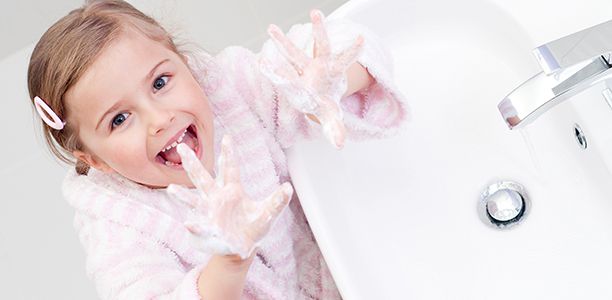Age
2 – 8 years
Duration of activity
About 10 minutes.
Materials/equipment
- Glitter
- Soap, running water and hand washing facilities which are appropriate for your child’s age
Cost
- You can pick up a tub of glitter for less than $2 if you don’t already have some at home. The hand washing products you should already have in your bathroom.
Preparation
- Make sure you have hand washing facilities that are appropriate for the children’s age.
- Remove any objects that you don’t want to get glitter on. Like germs, glitter spreads easily!
What to do
- You can play this game with one child or a group of children.
- Put a small amount of glitter in each child’s hands and tell them to rub their hands together so the glitter goes all over them. You could pour the glitter straight from the container, or spread it on a paper plate and let them place their hands lightly in it. If you use a plate, pour any excess glitter back in the container and discard the plate when you’re finished.
- Tell them the glitter is germs that cause diseases like colds and diarrhoea.
- Instruct your child to touch different parts of their body (e.g. their face and hair), other children (if you are playing in a group) and different objects in the room.
- Talk to your child about how the glitter sticks to everything they touch. Tell them that germs are the same, once they get on your hands they then spread to everything you touch.
- Now tell your child that to remove germs from their hands, they need to wash them.
- Go to the sink and help your child wash their hands with only water. DO NOT USE SOAP YET.
- When they have finished, talk about how there is still a lot of glitter on their hands, and the reasons why (because water alone is not enough to get germs off the hands, we also need to use soap).
- Now help your child wash their hands with soap and water using the proper hand washing technique.
- Talk about how soap helps water wash the germs away and that’s why it’s important to use soap every time you wash your hands.
Tips
 If you’re playing this game with a group of children, give each child a different colour glitter. When they have all finished touching things, you’ll be able to look at whose ‘germs’ spread to who.
If you’re playing this game with a group of children, give each child a different colour glitter. When they have all finished touching things, you’ll be able to look at whose ‘germs’ spread to who.- If you use different coloured germs you could tell each child they have a different type of germ, for example that green glitter is cold germs and red glitter diarrhoea germs. You could them talk about who caught the diseases when the germs spread, saying for example, ‘Jane has green cold germs on her nose, she’s caught a cold.” For older children you could use germs names like ‘influenza’ and ‘salmonella’.
- Be aware that some kids might find the idea of having germs on their hands unappealing or downright scary. It’s understandable because kids might associate germs with illness and days spent in bed and away from playing and other things they love. Be sure to explain that the germs are only pretend and will not really cause sickness. However, if your child still seems hesitant or scared, use a pair of cut out paper hands instead- run a glue stick over them before pouring the glitter so that it sticks.
Safety
- Supervise the children to make sure they don’t try and eat the glitter.
- Always keep an eye on your children while they are in the bathroom.
Educational outcomes
Awareness of health and wellbeing
Understanding how healthy habits like hand washing are related to keeping the body healthy is an important part of childhood development. Because children learn using their senses, understanding that germs which can’t be seen or smelt can cause disease can be a challenge. This game allows children to visualise germs and will help them understand the connections between hand washing and keeping themselves healthy.
Self care
Children learn how to care for themselves as they grow up. Washing hands is an important self-care task that most children can do for themselves by about age four. But practice makes perfect and this game also provides plenty of opportunities for practicing hand washing.
Being able to care for one’s own health, for example protect from infection by washing the hands, is also an important step in early childhood development. Young children depend on their parents a lot, but they take pride in being able to care for themselves. By about three years of age children can usually wash their hands independently. Before then, providing them opportunities to participate in self-care is an important way to encourage them to do it independently.
Communication skills
As you talk to your child about how germs spread you’ll be helping them develop the skills they’ll need to communicate effectively For example they will learn:
- The importance of listening to information.
- That they sometimes need to ask questions to get more information
- That people take it in turns to speak when they have a conversation.
Fine motor skills
Using a slippery bar of soap to wash the hands also exercises the small muscles that move the fingers and helps your child develop their fine motor skills.
Mathematical skills
Colour and quantity are key mathematical concepts which this game provides an opportunity for you to talk to your child about. For example if you get tell to choose which colour glitter they use you’ll be teaching them to recognise colours. You can also talk to them about how much glitter spreads, and how much stays on their hands.

More information about hand washing games and activities.
References
- Columbus Public Health. Teaching hand washing to young children. 2012. (cited 14 September 2013). Available from: (URL Link)
- Virginia Early Childhood Development Alignment Program. Milestones of child development- A guide to young children’s learning and development from birth to kindergarten. 2009. (cited 26 July 2013). Available from: (URL Link)
- National Childcare Accreditation Council Inc. Supporting children’s hygiene skills. 2009. (cited 24 August 2013). Available from: (URL Link)




 (12 votes, average: 3.67 out of 5)
(12 votes, average: 3.67 out of 5) 






